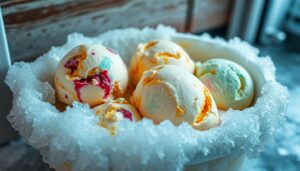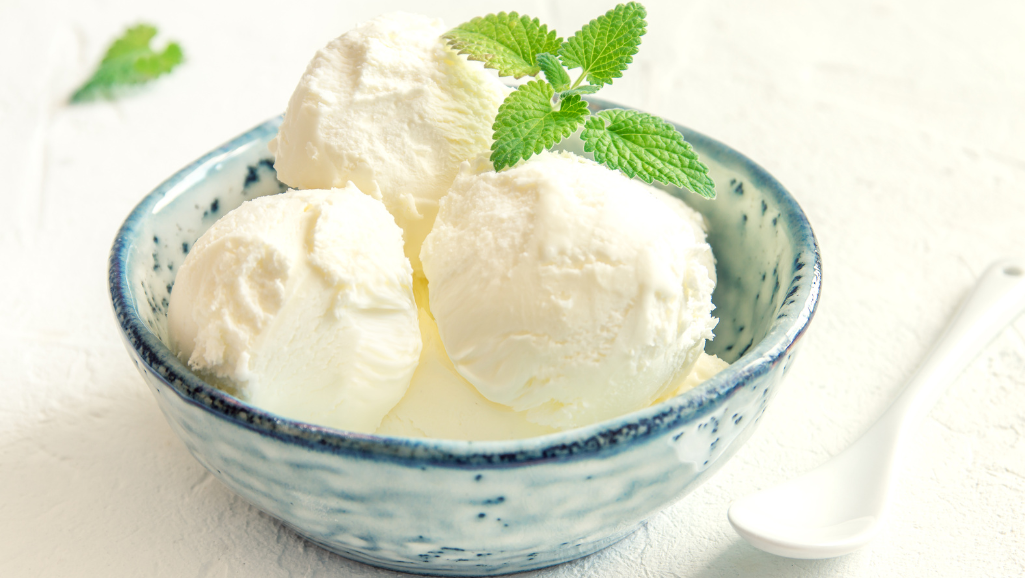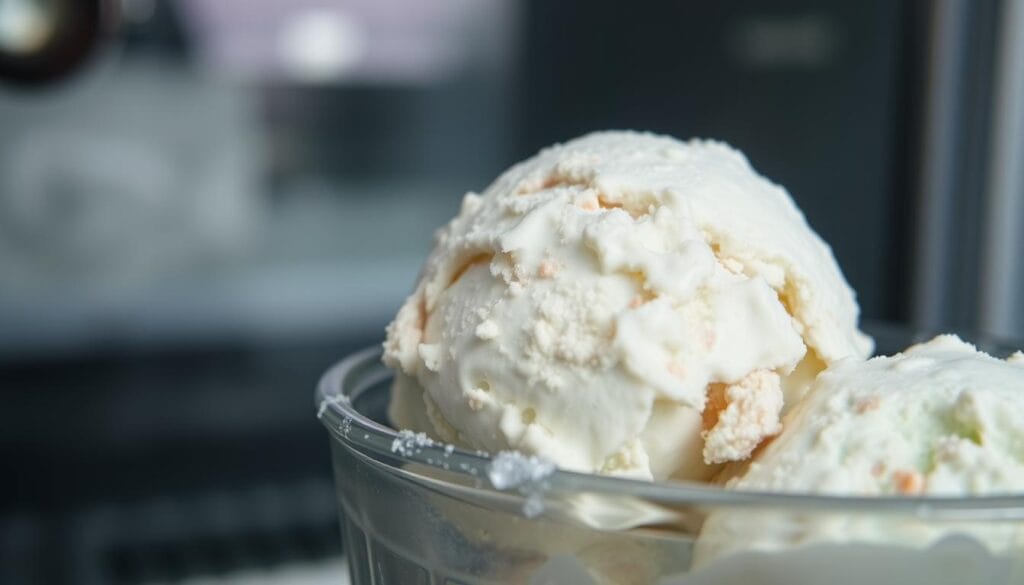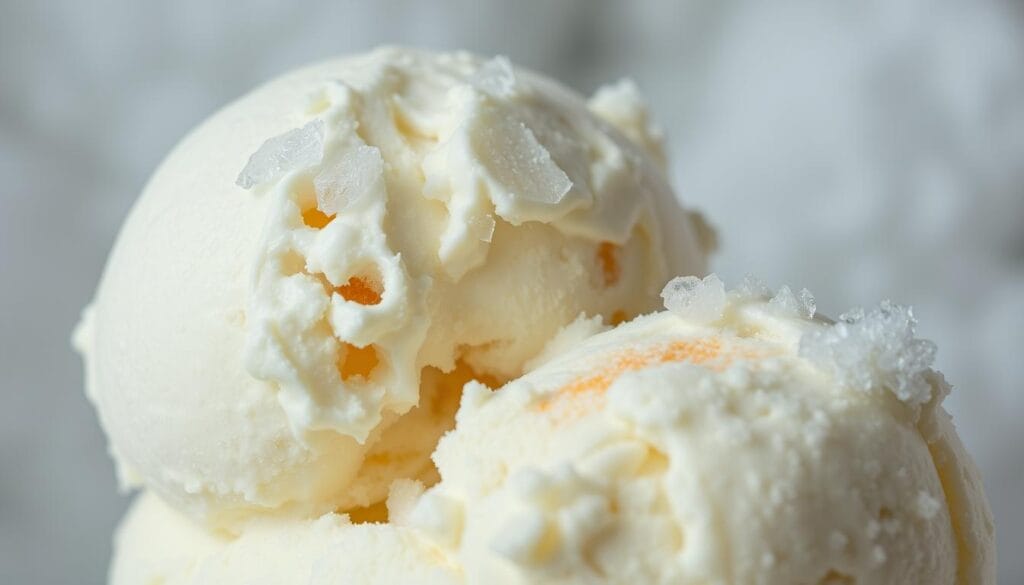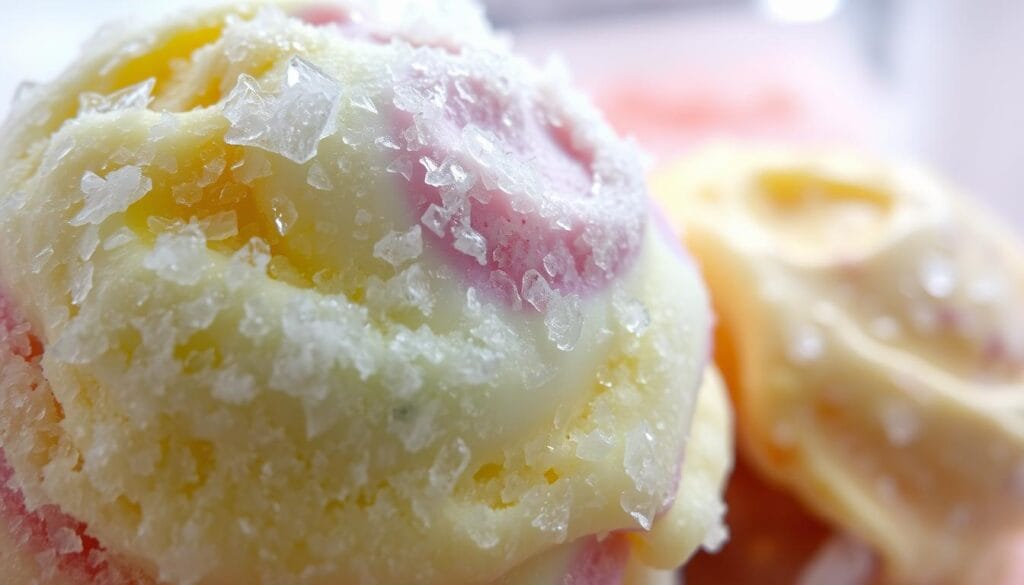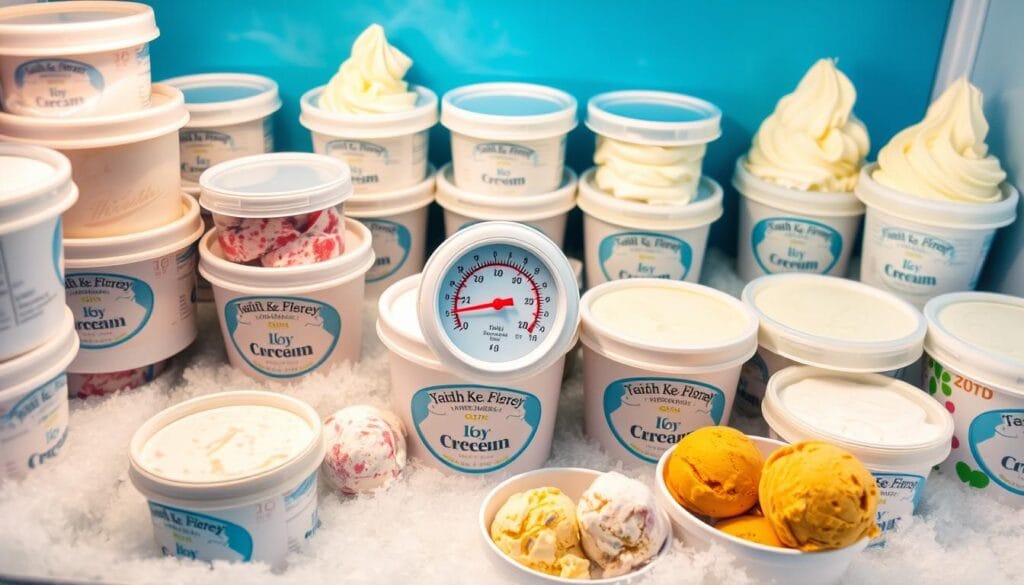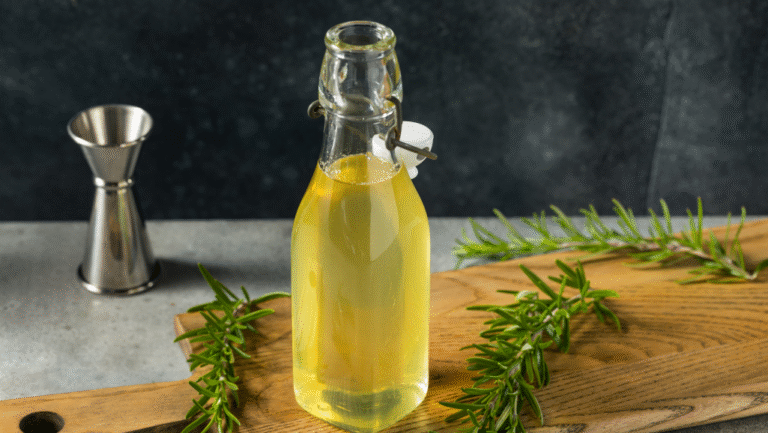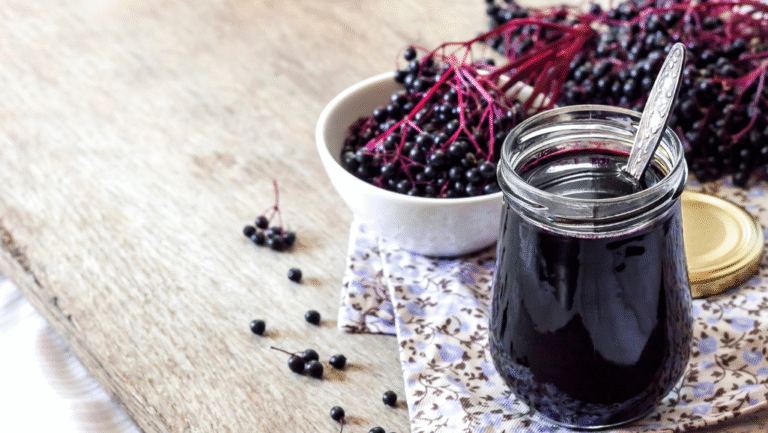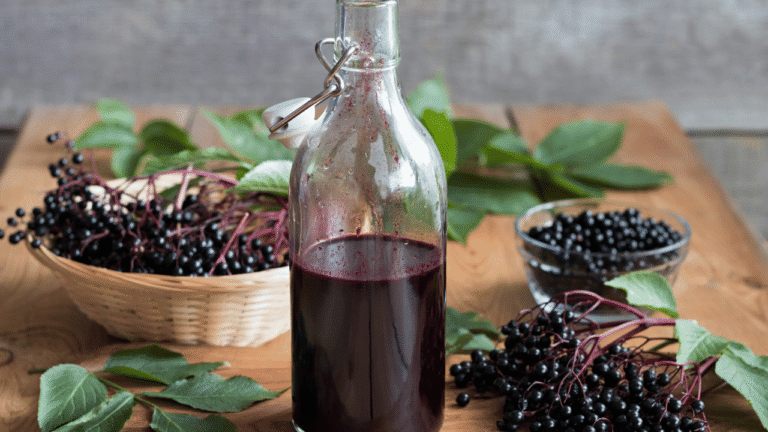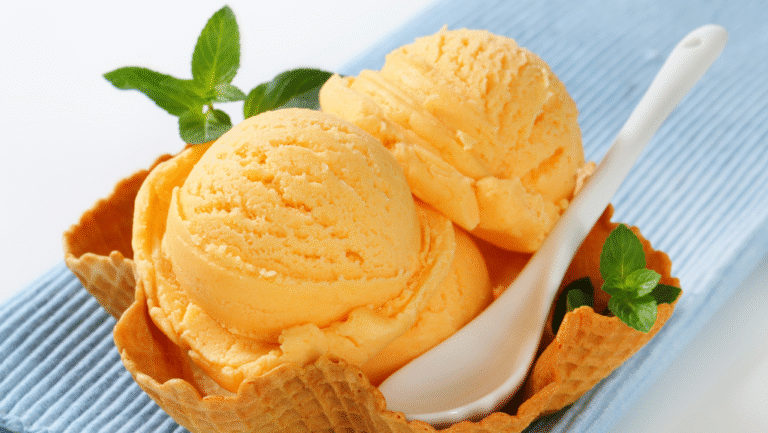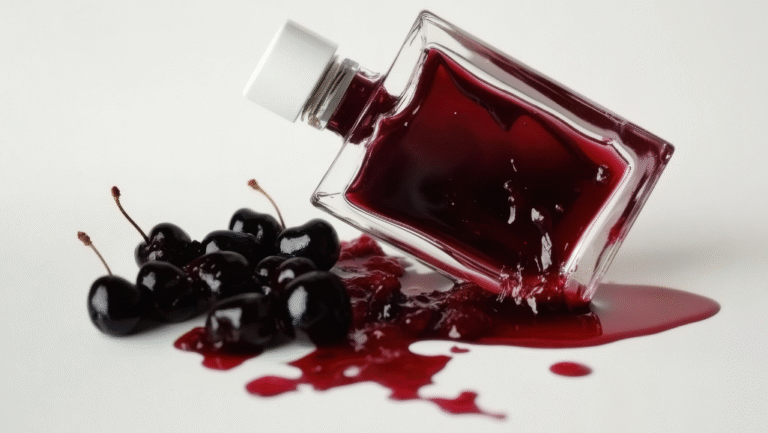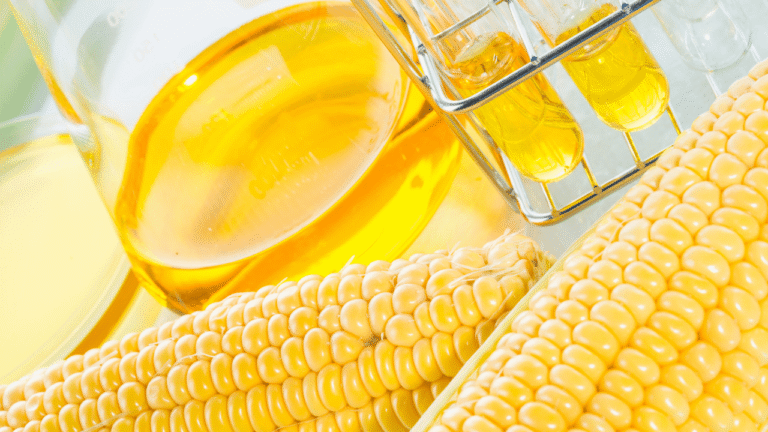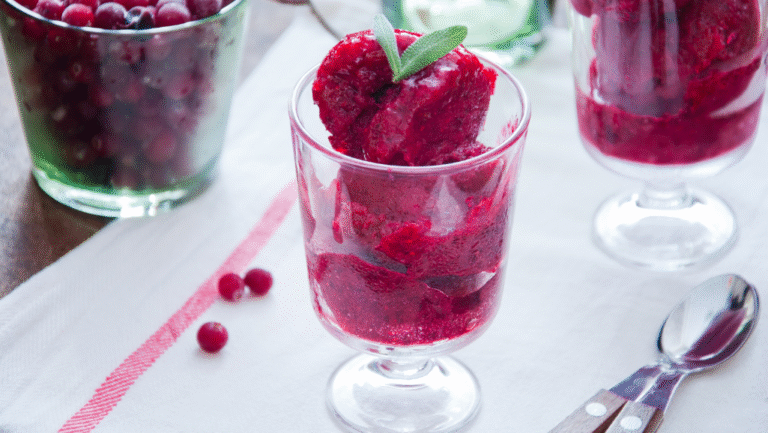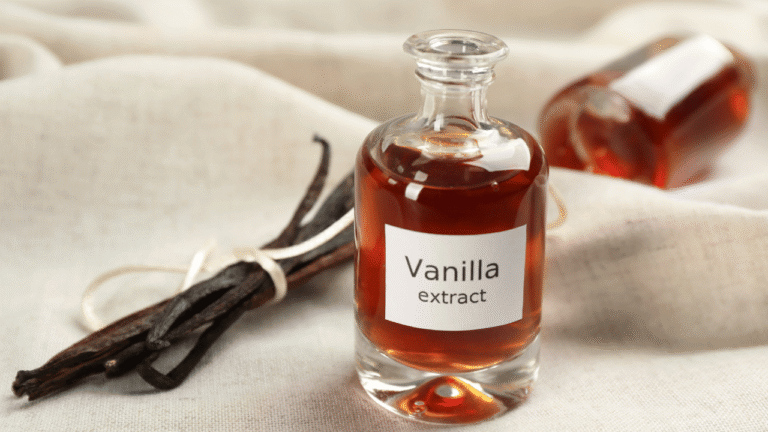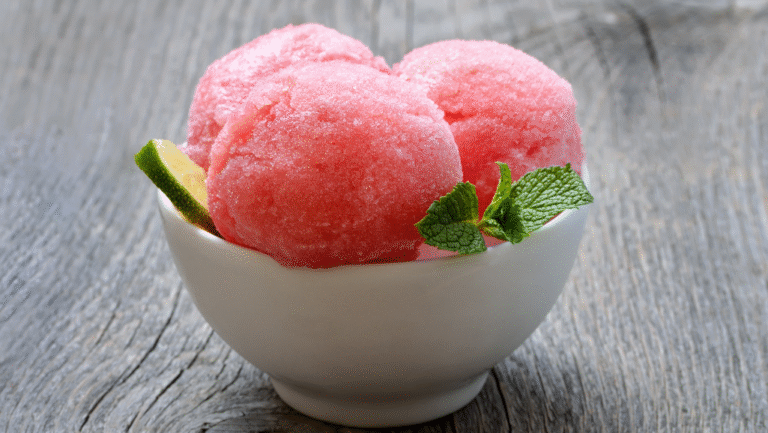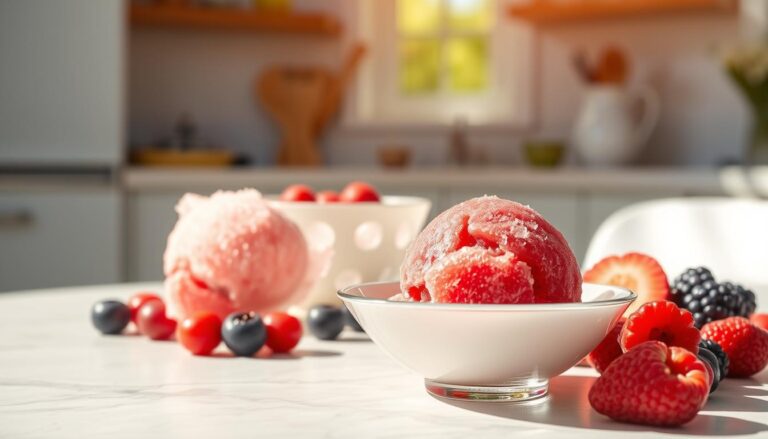Freezer burn is a common problem that can ruin ice cream’s quality and taste. It happens when ice cream’s surface moisture evaporates and then freezes again. This creates ice crystals that change the texture and flavor. To keep ice cream smooth and creamy, preventing freezer burn is key. It’s also important to understand how it occurs to ensure ice cream stays fresh longer.
Experts say the best freezer temperature for ice cream is between zero and 25 degrees below zero. Store-bought ice cream can last up to a year, while homemade ice cream lasts about three months. Keeping ice cream in the freezer without freezer burn for weeks is possible with the right storage.
Some ice cream flavors are more likely to get freezer burn. This includes flavors with more air, sugar, alcohol, and less fat. To avoid freezer burn, don’t let ice cream melt and freeze again. Store it at the freezer’s back, seal it well, and even consider storing it upside down, as Ben & Jerry’s suggested in 2020.
Key Takeaways:
- Freezer burn occurs when moisture evaporates and refreezes on the surface of ice cream, affecting its texture and flavor.
- Proper ice cream storage techniques, such as maintaining optimal freezer temperature and minimizing air exposure, are key to preventing freezer burn.
- Store-bought ice cream can last up to a year in the freezer, while homemade ice cream has a shorter shelf life of up to three months.
- Certain ice cream flavors with higher overrun, sugar, alcohol content, and lower fat content are more prone to developing freezer burn.
- Experts recommend storing ice cream at the back of the freezer, sealing it properly, and even storing it upside down to prevent ice crystals formation.
Simple Homemade Vanilla Ice Cream
4
servings30
minutes40
minutes300
kcal1
hour10
minutesEasy and delicious homemade vanilla ice cream recipe for beginners.
Keep the screen of your device on
Ingredients
2 cups 2 heavy cream
1 cup 1 whole milk
0.75 cup 0.75 granulated sugar
1 tablespoon 1 vanilla extract
1 pinch 1 salt
Directions
- In a medium saucepan, combine the heavy cream, whole milk, and granulated sugar over medium heat. Stir constantly until the sugar has completely dissolved.
- Remove the mixture from the heat and stir in the vanilla extract and salt, ensuring everything is well mixed.
- Pour the mixture into a large bowl and cover it with a plastic wrap. Chill it in the refrigerator for at least 2 hours or until completely cold.
- Prepare your ice cream maker according to the manufacturer's instructions, and pour the chilled mixture into it.
- Churn the ice cream mixture in the ice cream maker for 15-20 minutes, or until it reaches a soft-serve consistency.
- Transfer the churned ice cream into a lidded container and freeze for at least 4 hours or until firm.
- To serve, remove the ice cream from the freezer and let it sit for a few minutes to soften slightly before scooping.
Nutrition Facts
- Serving Size: 2g
- Total number of serves: 6
- Calories: 210kcal
- Fat: 12g
- Saturated Fat: 7g
- Trans Fat: 0g
- Polyunsaturated Fat: 0g
- Monounsaturated Fat: 0g
- Cholesterol: 45mg
- Sodium: 40mg
- Potassium: 70mg
- Carbohydrates: 20g
- Fiber: 0g
- Sugar: 20g
- Protein: 2g
- Vitamin A: 500IU
- Vitamin C: 0mg
- Calcium: 6mg
- Iron: 0mg
- Vitamin D: 1mg
- Vitamin E: 0mg
- Vitamin K: 0mg
- Thiamin: 0mg
- Riboflavin: 0mg
- Niacin: 0mg
- Vitamin B6: 0mg
- Vitamin B12: 0mg
- Folate: 0mg
- Biotin: 0mg
- Pantothenic Acid: 0mg
- Phosphorus: 0mg
- Iodine: 0mg
- Magnesium: 0mg
- Zinc: 0mg
- Selenium: 0mg
- Copper: 0mg
- Manganese: 0mg
- Chromium: 0mg
- Molybdenum: 0mg
- Chloride: 0mg
Did you make this recipe?
Tag @https://www.instagram.com/ice_cream_haven/ on Instagram and hashtag it with #IceCreamIceCreamHavens
Like this recipe?
Follow @https://www.pinterest.com/Ice_Cream_Haven/ on Pinterest
Join our Facebook Group!
Follow https://www.facebook.com/icecreamhavens/ on Facebook
What Is Freezer Burn Ice Cream?
Freezer burn ice cream happens when moisture escapes and forms ice crystals on the surface. This is due to cold, dry air in the freezer. It makes the ice cream dehydrate and look bad. Cary Frye, an ice cream expert, says uneven temperatures can also cause frost.
Freezer burn can ruin the ice cream’s texture and taste. But, it’s safe to eat, as long as it’s been kept at 0°F or below, says the USDA.
Understanding Ice Crystals on Ice Cream
Ice crystals on ice cream show freezer burn. They form when moisture evaporates and refreezes. This leaves the ice cream dry and icy. Freezer burn can happen even at the right temperature. It’s more likely if the ice cream is stored for a long time or if the container is opened and closed often.
The Appearance of Frost on Ice Cream
Freezer burn also shows as frost on the ice cream’s surface. This frost is made of ice crystals from moisture loss and refreezing. Seeing frost means freezer burn has happened, and the ice cream’s quality may have dropped.
“Once freezer burn occurs, its effects are not reversible, but salvaging the undamaged core might provide a pleasant taste.” – Jeni Britton Bauer, founder of Jeni’s Splendid Ice Creams
Even though freezer burn ice cream looks bad, the right storage can prevent it. Ben & Jerry’s says to keep ice cream below 0°F to avoid freezer burn. Real Simple suggests storing ice cream pints upside down to stop drips from causing crystals.
Causes of Freezer Burn on Ice Cream
Freezer burn on ice cream can ruin its quality and taste. Several factors lead to this problem, affecting the texture and flavor. Let’s look at the main causes of freezer burn on ice cream.
Exposure to Cold, Dry Air
Exposure to cold, dry air in the freezer is a big cause of freezer burn. If ice cream isn’t sealed well, it’s exposed to harsh conditions. The air draws out moisture, causing dehydration.
“Freezer-burnt foods may have an off-flavor and texture but are safe to eat if the freezer is set to 0°F (-18°C).”
Dehydration and Moisture Evaporation
Moisture evaporation speeds up as cold air keeps interacting with the ice cream. Water turns into ice crystals, making the ice cream icy. Foods with more water, like ice cream, are more prone to freezer burn.
To stop moisture loss, store ice cream in a sealed container. Keep the freezer at 0°F (-18°C) or lower. Homemade ice cream recipes suggest covering the ice cream with plastic wrap or wax paper before sealing.
Refreezing of Melted Ice Cream
Refreezing melted ice cream also causes freezer burn. When ice cream melts and then freezes again, it forms bigger ice crystals. This speeds up moisture loss and worsens freezer burn.
To prevent this, keep the freezer temperature steady. Avoid letting ice cream melt for too long. If it’s softened, eat it quickly to avoid freezer burn.
How Does Ice Cream Get Freezer Burn
Ice cream is a favorite frozen treat, but it can get freezer burn. Freezer burn happens when frozen food loses, making it drier and tougher. Even though it looks bad and feels odd, it’s safe to eat if stored right.
The Process of Moisture Evaporation and Refreezing
Moisture evaporation is key in freezer burn on ice cream. When ice cream meets air in the freezer, moisture on its surface evaporates. This leaves behind ice crystals that grow, making the ice cream look frosty.
When ice cream melts and then freezes again, it gets grainy. This happens because the moisture spreads unevenly, causing ice crystals to grow bigger.
The Role of Air Exposure in Freezer Burn Formation
Air in freezers helps freezer burn form on ice cream. If ice cream isn’t in a sealed container, it loses moisture and gets ice crystals. This makes it less creamy and flavorful.
Ice cream and frozen desserts can develop a thick ice crystal covering leading to a loss of flavor and creamy texture.
To avoid freezer burn, keep ice cream in sealed containers. Also, try to keep the freezer door closed as much as you can. A consistent freezer temperature of 0°F (-18°C) helps keep your ice cream fresh.
Impact of Freezer Burn on Ice Cream Quality
Freezer burn can really affect your favorite frozen treats. It changes the texture and flavor of ice cream. Knowing how freezer burn impacts ice cream helps keep it at its best.
Changes in Ice Cream Texture
Freezer burn makes ice cream feel grainy and icy. This is because moisture evaporates and then refreezes, forming ice crystals. This makes the ice cream feel crunchy instead of smooth.
A study showed frozen chicken breast fillets became 31% tougher after 8 months. This shows how freezer burn can change food texture a lot.
Alterations in Ice Cream Flavor
Freezer burn also changes ice cream’s flavor. Moisture evaporates, taking away some of the flavors and aromas. This can make the ice cream taste stale or off.
Ice crystals can also dull the flavors, making the ice cream taste less intense. While freezer-burned ice cream is safe, it’s not as enjoyable to eat.
To keep your ice cream fresh, use airtight containers and store it at the back of the freezer. Minimize air exposure. These steps help preserve the texture and flavor of your ice cream.
“Indulging in a scoop of smooth, creamy ice cream is one of life’s simple pleasures. By understanding and preventing freezer burn, you can ensure that every spoonful delivers the perfect texture and flavor, just as it should.”
No-churn ice cream recipes are a great way to enjoy homemade ice cream without an ice cream maker. They use heavy whipping cream and sweetened condensed milk for a creamy texture. Proper storage keeps your no-churn ice cream fresh for months, avoiding freezer burn.
For more information, check out no-churn ice cream recipes online.
Signs of Freezer Burn in Ice Cream
Freezer burn can ruin your favorite ice cream. Knowing the signs of freezer burn helps you avoid bad ice cream. This way, you can enjoy the best taste and texture.
Ice crystals on the surface are a clear sign of freezer burn. These crystals form when ice cream moisture freezes again on the surface. The more crystals, the worse the freezer burn.
Discoloration is another sign. Freezer-burned ice cream looks dull or grayish. This happens because dehydration and oxidation occur when it’s exposed to air.
“Freezer-burnt foods may look unappetizing and have an unpleasant texture and off-flavor but are safe to eat if stored at 0°F (-18°C).”
Freezer-burned ice cream also smells and tastes bad. It might taste stale or even a bit like plastic. This is because moisture loss and air exposure damage the ice cream’s flavors.
Even though it’s safe, freezer-burned ice cream isn’t as good as fresh. To avoid freezer burn, store ice cream in an airtight container. Also, eat it within the recommended time.
- Ice cream loses its creaminess when freezer burnt and gains ice crystals instead.
- Food with higher water content such as produce, meats, poultry, fish, or ice cream is more prone to freezer burn compared to foods with low water content like nuts, seeds, or flour.
By knowing the signs of freezer burn and preventing it, your ice cream stays delicious. Enjoy every scoop!
Preventing Freezer Burn Ice Cream
Freezer burn can ruin your favorite ice cream. But, with the right storage, you can avoid it. Here are some tips to keep your ice cream fresh and tasty:
Proper Ice Cream Storage Techniques
To stop freezer burn, store your ice cream right. Place it at the back of the freezer for a steady temperature. This keeps your ice cream from getting freezer burn. Don’t store it in the freezer door, as it changes temperature a lot.
Maintaining an Airtight Seal
Keeping your ice cream in a sealed container is key. After scooping, quickly put it back in the freezer. Make sure the lid is tight. You can also use plastic wrap or wax paper to cover it before putting the lid back on.
Optimal Freezer Temperature Settings
Keep your freezer at 0°F (-18°C) or colder. This temperature stops ice crystals from forming on your ice cream. Ice crystals can cause freezer burn.
Minimizing Exposure to Air
Air exposure is a big cause of freezer burn. Scoop your ice cream fast to avoid air getting in. Don’t leave the container open for too long. This lets cold, dry air in and causes moisture to evaporate. Use small containers to reduce air exposure each time you open it.
By following these tips for proper ice cream storage, airtight seal, optimal freezer temperature, and minimizing air exposure, you can prevent freezer burn. A little extra care can keep your ice cream’s texture and flavor perfect.
Conclusion
Freezer burn on ice cream can be a letdown. But, with the right steps, you can avoid it. Knowing why freezer burn happens helps a lot. It’s caused by cold, dry air and melting ice cream that freezes again.
Storing ice cream right is key to avoiding freezer burn. This way, you can always enjoy your ice cream at its best.
To keep your ice cream perfect, store it in a sealed container at the freezer’s back. This spot keeps temperatures steady. Also, keep the freezer at 0°F (-18°C) or colder to stop melting and refreezing.
At parties, use insulated tubs or freezer bags for ice cream. They keep it cold and prevent freezer burn.
By following these tips, your ice cream will stay smooth and creamy. A little extra care means you can always have a great scoop. So, enjoy your favorite ice cream, knowing it will always taste great.

